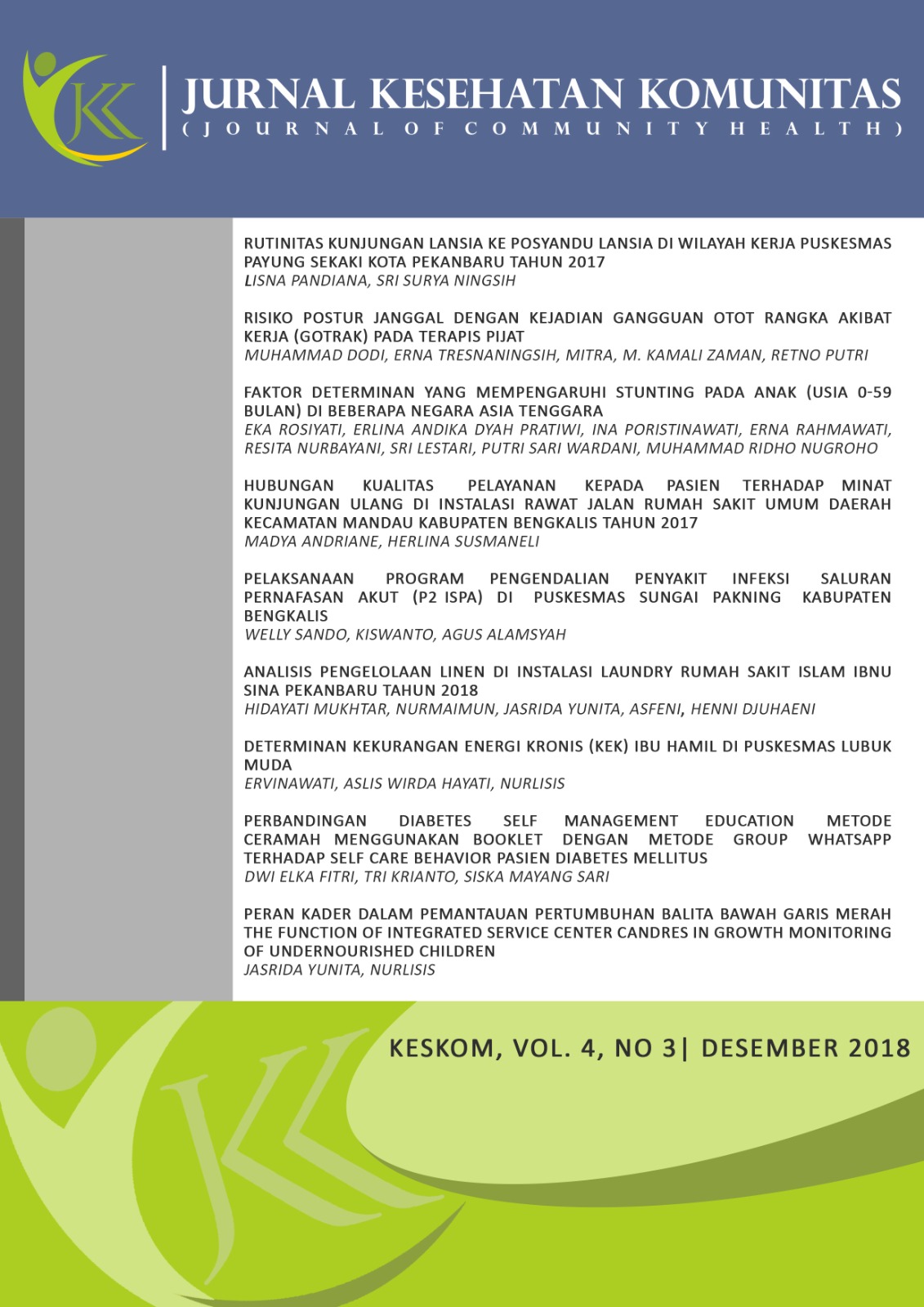Faktor Determinan yang Mempengaruhi Stunting pada Anak (usia 0-59 Bulan) di Beberapa Negara Asia Tenggara
English
DOI:
https://doi.org/10.25311/keskom.Vol4.Iss3.262Kata Kunci:
children under five years, socio-economic, Southeast Asia, StuntingAbstrak
Stunting adalah salah satu masalah gizi utama yang disebabkan oleh kekurangan gizi pada anak-anak usia dibawah 5 tahun. Faktor risiko stunting dipengaruhi oleh sosial ekonomi, Infant And Young Child Feeding (IYCF), penyakit infeksi, dan Water Sanitation and Hygiene (WASH). Faktor-faktor ini bervariasi diantara negara-negara Asia Tenggara sehingga diperlukan identifikasi mengenai faktor yang paling berpengaruh untuk merencanakan intervensi yang tepat. Penelitian ini menggunakan metode systematic review dengan
pendekatan Preferred Reporting Items for Systematic reviews and Meta-Analysis (PRISMA). Artikel diperoleh dari data base jurnal yaitu PubMed. Dari 14.790 arkel diidentifikasi hanya 60 artikel yang sesuai kemudian diperoleh 11 artikel yang memenuhi kriteria inklusi dan eksklusi yang berhubungan dengan stunting dibeberapa Negara Asia Tenggara. Berdasarkan hasil systematic review, sosial ekonomi merupakan salah satu faktor yang berhubungan dengan stunting di setiap negara Asia Tenggara. Pendapatan rumah tangga yang rendah, kurangnya pendidikan ibu, Praktek IYCF yang tidak sesuai, WASH, dan penyakit infeksi juga merupakan faktor yang memengaruhi stunting di negara Kamboja, Myanmar, Indonesia, Laos, Thailand,
dan Malaysia. Peningkatan sosial ekonomi seperti pendapatan ibu, perkembangan informasi kesehatan, peningkatan IYCF, WASH, dan penurunan penyakit infeksi diperlukan untuk melakukan perbaikan berkelanjutan dalam strategi spesifik yang melibatkan banyak faktor.
Unduhan
Referensi
Bhutta ZA, Das JK, Rizvi A, Gaffey MF, Walker N, Horton S, et al. (2013). Evidence-based interventions for improvement of maternal and child nutrition: What can be done and at what cost? Lancet.;382(9890):452–77.
Black RE, Victora CG, Walker SP, Bhutta ZA, Christian P, De Onis M, et al. (2013) Maternal and child undernutrition and overweight in low-income and middle-income countries. ;382(9890):427–51. Lancet.
Bryce J, Coitinho D, Darnton-Hill I, Pelletier D, Pinstrup-Andersen P. (2008). Maternal and child undernutrition: effective action at national level. Vol. 371, The Lancet. . p. 510–26.
Chaparro C, Oot L, Sethuraman K. (2014). Overview of the Nutrition Situation in Four Countries in South and Central Asia. Washington DC
Chaparro C, Oot L, Sethuraman K. (2014). Overview of the Nutrition Situation in Seven Countries in Southeast Asia .; Available from: https://www.fantaproject.org/sites/default/files/download/Southeast-Asia-Nutrition-Overview-Apr2014.pdf, Washington DC.
Cheah WL, Muda WAMW, Zamh Z-H. (2010). A structural equation model of the determinants of malnutrition among children in rural Kelantan, Malaysia. Rural Remote Health.10(1):1248. Malaysia
Committee for Population Family and Children and ORC Macro. (2011). Viet Nam Multiple Indicator Cluster Survey Final Report. Ha Noi
Food and Nutrition Research Institute. (2012). Nutritional Status of Filipino Children and Selected Population Groups Survey 2011. In: Nutrition Summit on The Nutritional Status of Filipino Children and Selected Population Groups: 2011. Makati;
Ikeda N, Irie Y, Shibuya K. (2013). Determinants of reduced child stunting in Cambodia: analysis of pooled data from three demographic and health surveys. Bull World Health Organ. May;91(5):341–9.
Kamiya Y. (2011). Socioeconomic determinants of nutritional status of children in Lao PDR: effects of household and community factors. J Health Popul Nutr. Aug;29(4):339–48.
Limwattananon S, Tangcharoensathien V, Prakongsai P. (2010). Equity in maternal and child health in Thailand. Bull World Health Organ. Jun;88(6):420–7.
Millward DJ. (2017). Nutrition, infection and stunting: the roles of deficiencies of individual nutrients and foods, and of inflammation, as determinants of reduced linear growth of children. Nutr Res Rev. Jun 23;30(1):50–72. Available from: https://www.cambridge.org/core/product/identifier/S0954422416000238/type/journal_article
Ministry of Health. Basic health research survey (Riset kesehatan dasar). (2013). Jakarta
Ramli, Agho KE, Inder KJ, Bowe SJ, Jacobs J, Dibley MJ. (2009). Prevalence and risk factors for stunting and severe stunting among under-fives in North Maluku province of Indonesia. BMC Pediatr. Oct;9(1):64.
Rawat R, Nguyen PH, Tran LM, Hajeebhoy N, Nguyen H Van, Baker J, et al. (2017). Social Franchising and a Nationwide Mass Media Campaign Increased the Prevalence of Adequate Complementary Feeding in Vietnam: A Cluster-Randomized Program Evaluation. J Nutr. 147(4):670–9.
Reinbott A, Kuchenbecker J, Herrmann J, Jordan I, Muehlhoff E, Kevanna O, et al.(2015). A child feeding index is superior to WHO IYCF indicators in explaining length-for-age Z-scores of young children in rural Cambodia. Paediatr Int Child Health. May;35(2):124–34.
Sahanggamu PD, Purnomosari L, Dillon D. (2017). Information exposure and growth monitoring favour child nutrition in rural Indonesia. Asia Pac J Clin Nutr. Mar;26(2):313–6.
Stevens GA, Finucane MM, Paciorek CJ, Flaxman SR, White RA, Donner AJ, et al. (2012) Trends in mild, moderate, and severe stunting and underweight, and progress towards MDG 1 in 141 developing countries: a systematic analysis of population representative data. Sep 1;380(9844):824–34. Available from: http://www.ncbi.nlm.nih.gov/pubmed/22770478 Lancet (London, England).
The World Bank. (2018). World Bank Country and Lending Groups . 2018 Available from: https://datahelpdesk.worldbank.org/knowledgebase/articles/906519-world-bank-country-and-lending-groups
Torlesse H, Cronin AA, Sebayang SK, Nandy R. (2016). Determinants of stunting in Indonesian children: evidence from a cross-sectional survey indicate a prominent role for the water, sanitation and hygiene sector in stunting reduction. BMC Public Health. Dec;16(1):669.
UNICEF. (2011). Programing Guide, Infant and Young Child Feeding. Nutrition Section Programmes. New York
Victora CG, Adair L, Fall C, Hallal PC, Martorell R, Richter L, et al. (2008). Maternal and child undernutrition: consequences for adult health and human capital. 26;371(9609):340–57. Available from: http://www.ncbi.nlm.nih.gov/pubmed/18206223 Lancet (London, England)
World Health Organization. (2010). Assessing Infant and Young Child Feeding Practices. Part 1: Definitions . Available from: http://www.who.int/nutrition/publications/infant feeding/9789241596664/en/
World Health Organization. (2012). Care for Child Development Improving the Care of Young Children.;. Available from https://www.unicef.org/earlychildhood/files/02_Improving_care__Belize_october_2015. Geneva
World Health Organization. (2018). The WHO Child Growth Standards. Child growth standards.. Available from: http://www.who.int/childgrowth/
Zhao A, Gao H, Li B, Zhang J, Win NN, Wang P, et al. (2016). Inappropriate Feeding Behavior: One of the Important Causes of Malnutrition in 6- to 36-Month-Old Children in Myanmar. Am J Trop Med Hyg. Sep;95(3):702–8.
Unduhan
Telah diserahkan
diterima
Diterbitkan
Cara Mengutip
Terbitan
Bagian
Lisensi
Copyright @2017. This is an open-access article distributed under the terms of the Creative Commons Attribution-NonCommercial-ShareAlike 4.0 International License (http://creativecommons.org/licenses/by-nc-sa/4.0/) which permits unrestricted non-commercial used, distribution and reproduction in any medium











































